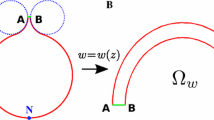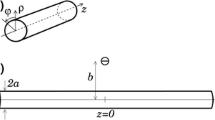Abstract
In order to increase the potentials recorded extracellularly from nerve fibres, peripheral nerves are often placed in restricted space with cylindrical geometry. Equations are derived for computing the potentials expected at the surface of the cylinder, based on the potentials at the external surface of a small nerve fibre located on the long axis of the cylinder. These equations are evaluated numerically, using two formulae for a nerve impulse given in the literature. In both cases there is little attenuation for cylinders with radii less than 0.5 mm, but the potential declines approximately as a power of radius b for 1<b<10 mm. Various factors which might affect these results under different experimental conditions are discussed.
Similar content being viewed by others
References
Clark, J., Plonsey, R.: The extracellular potential field of the single active nerve fiber in a volume conductor. Biophys. J. 8, 842 (1968)
Hodgkin, A.L.: A note on conduction velocity. J. Physiol. 125 221 (1954)
Huxley, A.F.: Ion movements during nerve activity. Ann. N.Y. Acad. Sci. 81, 221 (1959)
Marks, W.B., Loeb, G.E.: Action currents, internodal potentials, and extracellular records of myelinated mammalian nerve fibres derived from node equations. Biophys. J. 16, 655 (1976)
Paintal, A.S.: The influence of diameter of medullated nerve fibres of cats on the rising and falling phases of the spike and its recovery. J. Physiol. 184, 791 (1966)
Pearson, K.G., Stein, R.B., Malhotra, S.K. Properties of action potentials from insect motor nerve fibres. J. Exp. Biol. 53, 299 (1970)
Plonsey, R.: The active fiber in a volume conductor. IEEE Trans. Biomed. Engng. 21, 371 (1974)
Rosenfalck, P.: Intra- and extra-cellular potential fields of active nerve and muscle fibres. Acta Physiol. Scand. Suppl. 321, 1 (1969)
Ruch, T.C., Patton, H.D.: Physiology and Biophysics. Philadelphia-London: Saunders (1965)
Stein, R.B., Charles D., Davis, L., Jhamandas, J., Mannard, A., Nichols, T.R.: Principles underlying new methods for chronic neural recording. Can. J. Neurol. Sci. 2, 235 (1975)
Stein, R.B., Nichols, T.R., Jhamandas, J., Davis, L., Charles, D.: Stable long-term recordings from cat peripheral nerves. Brain Res. 128, 21 (1977)
Stein, R.B., Pearson, K.G.: Predicted amplitude and form of extracellularly recorded action potentials from unmyelinated nerve fibres. J. Theor. Biol. 32, 539 (1971)
Tasaki, I.: A new measurement of action currents developed by single nodes of Ranvier. J. Neurophysiol. 27, 1199 (1964)
Author information
Authors and Affiliations
Additional information
This research was supported by grants (to R.B.S.) from the Medical Research Council and (to M.N.O.) the National Research Council of Canada. We thank Mrs. M. Willard for help with computer programming, and Dr. S. Andreassen for helpful comments on the manuscript
Rights and permissions
About this article
Cite this article
Stein, R.B., Oğuztöreli, M.N. The radial decline of nerve impulses in a restricted cylindrical extracellular space. Biol. Cybernetics 28, 159–165 (1978). https://doi.org/10.1007/BF00337137
Received:
Issue Date:
DOI: https://doi.org/10.1007/BF00337137




